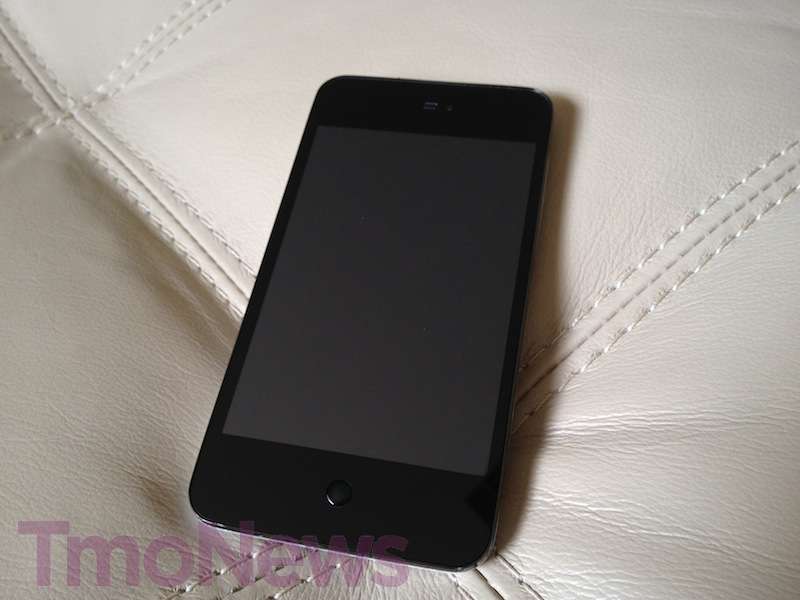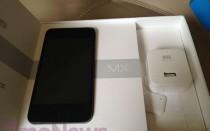TmoNews Reviews The Meizu MX, Pentaband Unlocked Glory
Editors Note: This isn’t a typical review for TmoNews as this isn’t a T-Mobile branded device. However, given T-Mobile’s current refarming project and the notion that we’ll seen be able to use a multitude of unlocked and non-T-Mobile phones on the network, I’m going to step up some reviews of devices that will work on T-Mobile’s network.
When it comes to T-Mobile, one of the many things I love about the Magenta network is the ability to bring any handset to the network and have it work. This was the case with the Meizu MX, a device that was provided to me by Meizu and ends up as one of my favorite Android devices, albeit with a wrinkle or two. The name Meizu isn’t one we typically see here in the US. They aren’t available on any carrier and if you do recognize the name, it’s likely your familiarity is due to their earlier legal troubles with Apple. However, when I caught word that Meizu had a pentaband device with a quad-core processor, the very same processor as found in the international version of the Galaxy S III, I knew I had to try this.
Off I went to find a contact at Meizu and, around 10 days later, I had the Meizu MX in my hands. I’ve made no bones about loving the 4″ Android phone and this is quite honestly my perfect device. I will amend this post right away and say that my review unit is an engineering sample so that’s something to keep in mind. That often means a niggle or two is expected as we tend to become guinea pigs with units and our problems are used to help make a better experience for everyone else buying the phone.
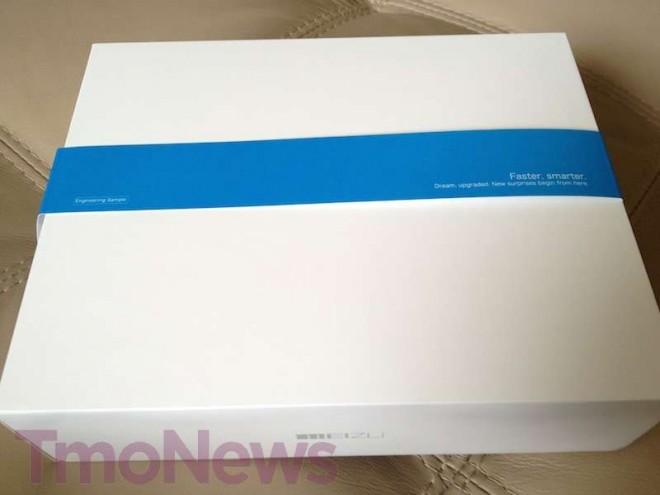 The box the Meizu MX arrived in is a thing of beauty, an all white box with a blue ribbon and it felt like Christmas morning. There is a Chinese plug in the box, so I tossed that aside and went right for the phone and the “book” that the phone arrived with. In a hidden compartment on the backside of the “book” is a USB cord, SIM card adapter and a tool to help remove the back plate of the phone. No headphones were sent with the box and I’m not sure if that’s because this is an engineering unit or if they just don’t come with the device, but either way I have plenty to play with.
The box the Meizu MX arrived in is a thing of beauty, an all white box with a blue ribbon and it felt like Christmas morning. There is a Chinese plug in the box, so I tossed that aside and went right for the phone and the “book” that the phone arrived with. In a hidden compartment on the backside of the “book” is a USB cord, SIM card adapter and a tool to help remove the back plate of the phone. No headphones were sent with the box and I’m not sure if that’s because this is an engineering unit or if they just don’t come with the device, but either way I have plenty to play with.
It’s likely that you’ve never seen a Meizu MX before and there’s a good chance you never will. They aren’t generally found outside of China and that’s ok. The hardware is an absolute iPhone-like experience while the Android interface takes care of that side. All things considered, this phone is VERY reminiscent of the iPhone and while Android may grace the software side, this thing still screams Apple with its icon layout.
Hardware:
The hardware is a riddle wrapped in an enigma. It’s so very iPhone-like that just about everyone who looked at the phone in the past two weeks has thought it WAS the iPhone at first. If you didn’t notice the hardware button on the front or the placement of the camera in the middle of the backside of the device, you would be hard-pressed to notice a difference between the two – especially if you didn’t know what you were looking for. To the average passerby, this device screams iPhone. The home key on the front side of the device raises up just enough to be pressed, but not enough that I was accidentally kicking myself back to the home screen. In fact, I found the rounded shape pretty comfortable to use, more so than the Galaxy S III button. 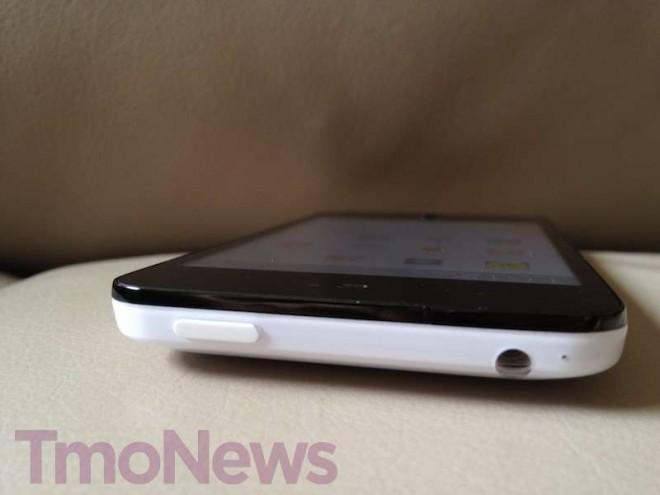
The capacitive keys that sit to the left and right of the home button are something I’ve not yet seen an Android manufacturer do before, and Meizu did it with excellent results. First, the keys light up dependent on the phone’s orientation of landscape vs vertical. they’ll know which direction to show. They will also change depending on the action available to you as the right side button will light up and show three dots when a menu is available and just one dot for everything else. The left side is basically a back key all the time and it appears to look like an arrow when the option to go back a screen is available.
Meizu’s website lists the screen itself as a 4″ 960 x 640 ASV screen with 288ppi, which is the same resolution as the iPhone’s Retina display, just a larger screen size. The VGA front-facing camera sits to the very right of the earpiece, with the 8 megapixel 1080p rear camera resting in the middle of the back of the device. On the left side of the unit sits the volume rocker button, with the right side being empty. The top of the phone has the power button and headphone outlet, and on the bottom of the phone sits the microUSB power outlet. There is a pair of speakers on the rear of the device, a pretty mysterious place for them as one tends to cover them up as you hold the phone in your hands.
For what it’s worth, removing the backplate to insert the microSIM was about the hardest task I’ve ever had to carry out. Seriously, I was able to pick a wedding venue easier than I was able to remove this backplate, which is why Meizu provides a tool to help remove the backplate. On one hand, I suppose it’s good to know how sturdy this is, but if you’re someone who changes phones as often as I do and constantly reaches for his SIM card, this is a bit of an annoyance. However, it has absolutely no bearing on the experience of using the phone, so it’s really just a mild complaint.
The 1,700 mAh battery appears to be user-replaceable, except it isn’t. It’s a tease, as it can’t be removed at all and you would have to really tear up the phone to get the battery out of its compartment. As batteries tend to get tucked away inside smartphones more and more, this isn’t as big of a deal as it once might have been, but we still like the idea of being able to change batteries at will, especially for power users or travelers.
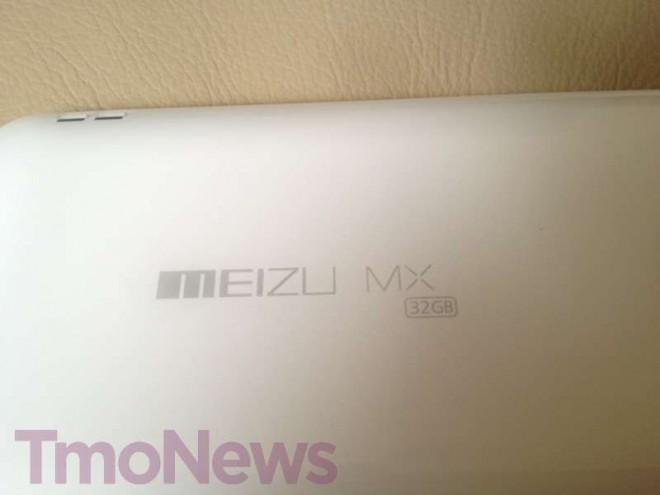 As for the hardware itself, the measurements of 121.3 x 63.3 x 10.3 mm make it incredibly comfortable for my personal tastes and, at 4.9oz, it’s 0.2 ounces heavier than the Galaxy S III. The phone’s backplate does feel a little slippery, but at no point was I ever concerned about it slipping out of my hands. In fact, I loved the size and feel of this phone. Yes, I know that larger screens are all the rage these days, but this baby just felt “right” in my hands. Hate away!
As for the hardware itself, the measurements of 121.3 x 63.3 x 10.3 mm make it incredibly comfortable for my personal tastes and, at 4.9oz, it’s 0.2 ounces heavier than the Galaxy S III. The phone’s backplate does feel a little slippery, but at no point was I ever concerned about it slipping out of my hands. In fact, I loved the size and feel of this phone. Yes, I know that larger screens are all the rage these days, but this baby just felt “right” in my hands. Hate away!
The Meizu MX display really is great, and it’s very difficult to spot any one individual pixel, unlike some Pentile displays hanging around these days. If you crank up the brightness a little, using the screen outdoors was very easy and that’s a great thing. Still, with all the display advancements that have come out lately, there isn’t anything about the MX which separates it from the pack. It’s still just a really good display. I found viewing angles to be pretty decent, and it’s really just a great screen.
Software:
Things really start to separate themselves with the MX when it comes to the software and interface part of the phone. Android 4.0.3 powers the device, but you’d be hard pressed to determine that since Meizu’s Flyme OS covers Android like a blanket. There is almost zero doubt that Flyme was inspired by the folks in Cupertino and I don’t think Meizu is making any effort to hide it. For one, there is no app drawer. Everything just resides on the home-screen, but there are folders. So that’s something. App shortcuts appear right on the home-screen immediately after installation and there they shall live forever. Removing the shortcut will remove the app itself. 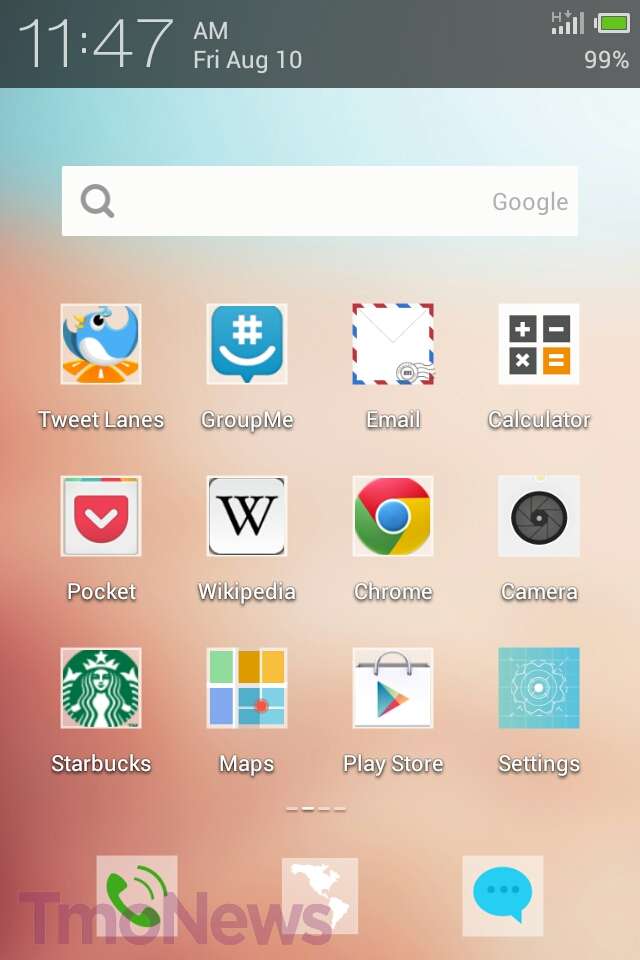
Flyme is very different from what we’re used to here in the US. It’s both easier to follow and yet much less detailed than Samsung’s TouchWiz or HTC’s Sense. Whether or not you view that as a good or bad thing is totally up to you. I, for one, had no qualms about the way Meizu pieced together their Android overlay and the lack of an app drawer never bothered me. As long as I have folders, organization isn’t much of a problem for me and I never felt like I was missing out on anything. Each folder will store up to 16 apps, and, if you want to remove them from the folder, just drag them outside and back onto the home-screen.
It’s clear that Meizu was focused on performance with their overlay, and not including some specific features from Ice Cream Sandwich. Of course, widgets are available, and I’ve already covered folders. Meizu completely stripped ICS of its new gallery app, music player, face unlock or calendar. If those features are important to you and you cannot live without them, the MX will disappoint you.
The lock-screen takes a slide-to-unlock turn with three separate shortcuts, one for jumping right into phone, one for messages and one for a general unlock. If the music player is active, a shortcut will play on the lock-screen as well which allows you to pause and select different songs.
Another distinctly different direction for Meizu was the notification area with five separate connectivity options: Wi-Fi, Data, Bluetooth, GPS and Sync. Actual notifications (e.g. messages, app updates, game alerts) all drop into the screen, but the notification menu never takes up the screen. The box itself will require scrolling to see all relevant notifications. This is good, a very good adaptation of the notification system on Android and I loved it.
Task switching on the MX is performed by holding the Menu key (right capacitive button) and items appear at the bottom of the screen. It’s a side-scrolling row of icons, showing four at a time in order of recently used. Apps can be killed by holding an icon and dragging it over the X or hitting the X and ending all the apps running in the background. The task switching menu also has music controls, which is very iPhone-like. Beginning to see a pattern here?
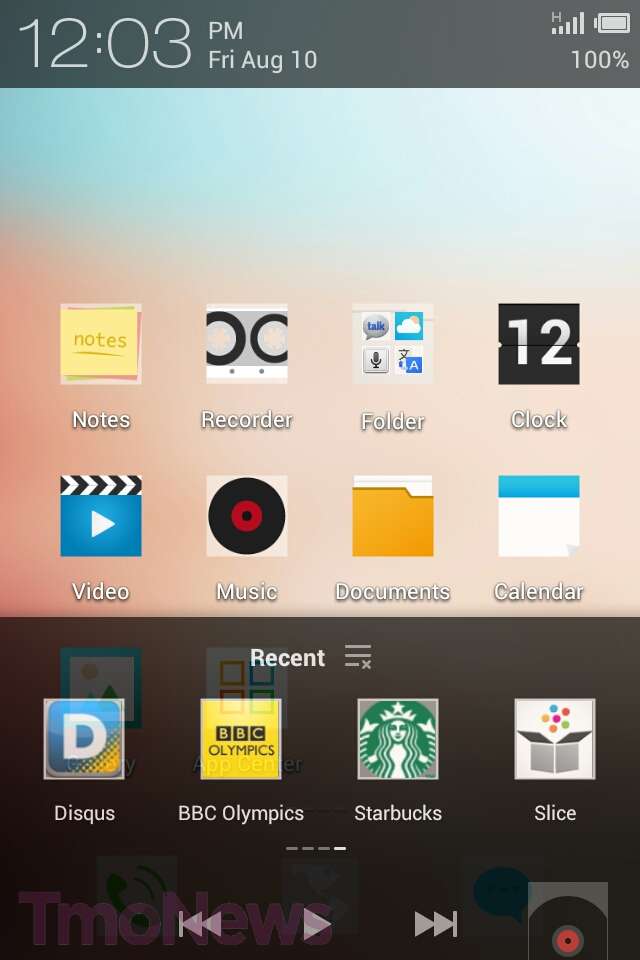 The app dock itself allows for five icons, though only four are capable of being switched as Meizu’s stock browser icon is a dock staple and cannot be removed. Still, this is Ice Cream Sandwich and Android so widgets and the entire Google Play market are at your disposal.
The app dock itself allows for five icons, though only four are capable of being switched as Meizu’s stock browser icon is a dock staple and cannot be removed. Still, this is Ice Cream Sandwich and Android so widgets and the entire Google Play market are at your disposal.
There are some nifty little features here in the Flyme OS though, such as the pressing and holding of the back button immediately puts the phone into standby mode. Pressing the home and power buttons will take a screenshot, though I suppose that’s a fairly standard inclusion in ICS these days, and pressing the top-right corner of the display will take you back to the top of whatever page you’re looking at.
One interesting drawback of the Google Play store is the limitation that just one download/app update may occur at a time. Core Google apps, such as Gmail and Google+ require download from the Google Play store, which we should mention is tucked away inside another folder upon taking the phone out of the box. Given that the phone is set for a Chinese market and Meizu has a pretty Flyme App Store available, that didn’t come as much of a surprise. In fact, I found the stock email program better than Gmail and ended up uninstalling Gmail altogether.
Another interesting quirk on the MX was the lack of a smart-dialer, though it will tell you the country based on the phone number. I guess that’s something. There is also an option for recording calls or recording portions of calls along with a blacklist which allows you to select phone numbers to filter out as spam. You can also set it so just calls in your phonebook are allowed in. Awesome.
Call Quality and Battery Life:
When it comes to call-quality, voices sounded great on both sides and reception was never a problem. The built-in speaker was plenty loud, though if you are using speakerphone and keeping the phone in your hand, just be sure to stay away from the speaker on the back.
Battery life with the 1,700 mAh battery was pretty good and it lasted through a complete day of mostly moderate usage. However, battery life brings us into a piece of the Meizu MX that struck me as both interesting and questionable. Unlike most phones which require hacks and tweaks to adjust the processor speed, Meizu comes with three separate settings for processor speed: low, medium and high. I won’t even get into low, because who wants to use it at low. By default, it comes out of the box with medium selected, which clocks the processor in at 1GHz. It’s a weird move by Meizu and I’m not sure what the 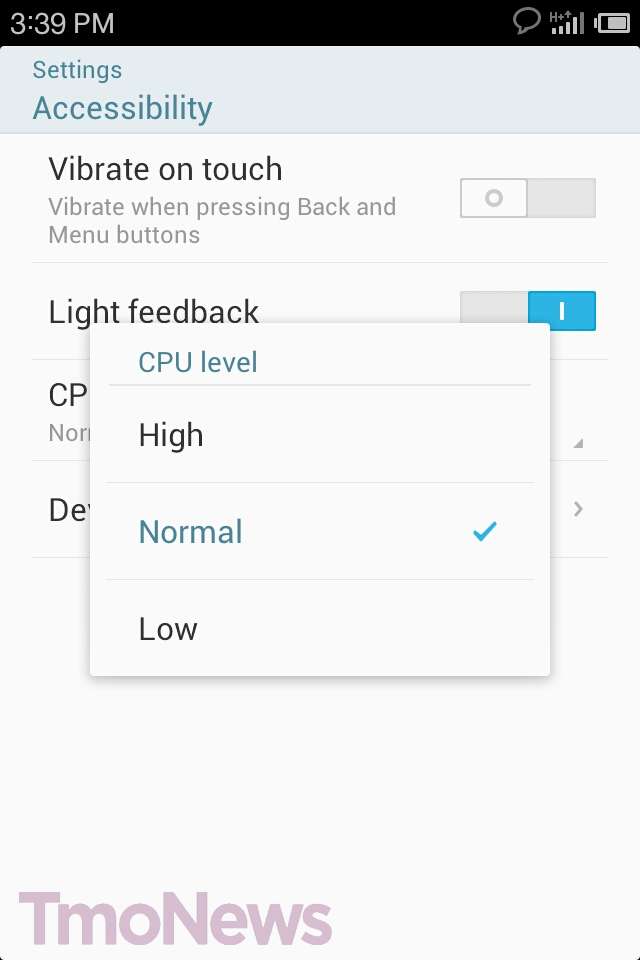 reasoning is behind this move, however a quick flip of a switch and I’m at high and pushing out that Exynos quad-core processor. When the Exynos is selected on high, this bad boy puts out some beautiful numbers on quadrant, besting my Galaxy S III with a score of 5220 to 4551. The flip-side to running it on high is the shortened battery life which, even with moderate usage, saw me needing the plug in for battery life around early evening. I’m a power user for sure, and granted there were times on high I was pushing the phone as much as possible and doing more tasks than I “regularly” would, but having a charger handy is recommended if running this thing on “high” is your de-facto setting.
reasoning is behind this move, however a quick flip of a switch and I’m at high and pushing out that Exynos quad-core processor. When the Exynos is selected on high, this bad boy puts out some beautiful numbers on quadrant, besting my Galaxy S III with a score of 5220 to 4551. The flip-side to running it on high is the shortened battery life which, even with moderate usage, saw me needing the plug in for battery life around early evening. I’m a power user for sure, and granted there were times on high I was pushing the phone as much as possible and doing more tasks than I “regularly” would, but having a charger handy is recommended if running this thing on “high” is your de-facto setting.
Network:
When it comes to internet speed, the phone has a radio capable of HSPA+ 21Mbps and it showed. I was regularly hitting speeds in the 10-12 range on T-Mobile’s network. Web-browsing was never a concern and downloading apps didn’t seem any slower than using a T-Mobile branded device with a 42Mbps radio. Of course, the real time you’ll see a difference between those two speeds is when downloading larger files than an app with a size of few MB.
Before and After:
Now for a couple of those little niggles that came my way while using the Meizu, and the before and after experience I had with Meizu. There are two aspects of the MX that were driving me crazy. The first was the GPS receiver and how long it took to lock my location, if it locked it at all, and the second one was something a little more major. My first week with the phone was marred by black screens and random reboots. In fact, one day while waiting on hold for a painter, the phone shut off completely and I had no idea the phone was off. I merely thought nobody cared about talking to me. As it turned out, the phone had shut off. So those were the problems.
However, there was a solution. After pinging Meizu on their @Meizu Twitter account, I was told they were aware of the problems and that a fix was on the way. In all honesty, Meizu is hardly the first company to have either of these problems and they won’t be the last, so I decided to wait. Like all good things, the software came while I waited and I updated Flyme OS to version 1.0.3 and, voila, a brand new phone! GPS locked within seconds and in the week I’ve used the phone again on this new software, not a single lock-up, reboot, black screen or any of the previous problems that occurred when I first unwrapped this Chinese superstar.
Closing Thoughts:
When it comes to making a final decision on the Meizu MX, the first thing I have to say is that as an unlocked phone, you’ll have to dive into your pocket to bring one stateside. That could run upwards of $400, which for those of you familiar with buying unlocked phones is pretty par for the course and is, in fact, less expensive than buying some of T-Mobile’s staple phones off contract.
Money aside, the Meizu MX is a sleeper in the smartphone world and it’s got enough going for it to keep you not only interested but impressed. Yes, a few software problems marred my first few days, but I’m seriously in love with this phone and I would have zero problem picking one up online. It’s powerful, even with a plasticky-feeling back and an iPhone-like Android overlay. It’s still one of the most powerful Android phones on the market. Meizu’s Flyme OS wants to keep everything simple, and the hardware itself is future proof. I don’t have any indication if Meizu will update their MX line to Jelly Bean, but I’d like to think it would run Jelly Bean like a champ.
If premium build quality is important to you, Sony has plenty of devices you can use. The Meizu, like the Galaxy S III, has a very plasticky feel as I stated earlier, but like the Samsung, it doesn’t hurt the experience of the phone at all. I know I’m a fan of 4″ Android phones and I’ve longed to find a powerful Android phone that fits the bill at the size I love. Thankfully, I don’t have to look any further than the Meizu MX. Even as a device that’s supposed to be a “budget” option, it packs far more than most high-end devices in the US and with a quad-core processor, if you’re up for shelling out the cash, you should take a long hard look at the Meizu MX.

